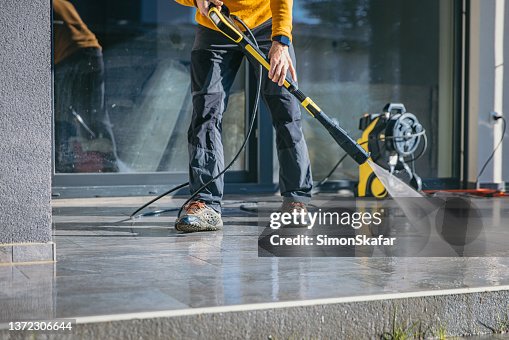Stress Laundering 101: Tips and Techniques for a Pristine Outside
Stress cleaning serves as a vital device in preserving the aesthetic allure of various external surfaces, effectively removing built-up dirt and discolorations. As we explore these necessary aspects, you'll find just how to elevate your stress washing abilities and guarantee your home continues to be in pristine problem.
Recognizing Stress Laundering
Recognizing pressure cleaning is vital for accomplishing optimum outcomes in outside cleaning projects. This technique uses high-pressure water spray to eliminate dirt, grime, mold and mildew, and other pollutants from different surfaces, significantly improving the visual allure and long life of landscapes and frameworks.
The procedure entails making use of specific devices that generates water stress usually ranging from 1,500 to 4,000 psi, depending upon the surface area and cleaning requirements. For example, softer surfaces like timber might necessitate lower stress setups to stay clear of damages, while concrete can withstand higher pressures for efficient cleaning. In enhancement to stress, the temperature of the water can likewise play a crucial function; warm water can liquify grease and oil more successfully than cold water.
Picking the suitable nozzle is one more crucial element, as different nozzles develop differing spray patterns and stress degrees. Understanding the types of surface areas-- such as vinyl, block, or asphalt-- assists in customizing the stress cleaning technique to prevent possible damage.

Vital Equipment Required
To begin a successful stress washing task, having the right tools available is important. First of all, a reliable stress washing machine is the centerpiece of your setup. Select one with flexible stress setups, normally ranging from 1,500 to 3,000 PSI, relying on the surfaces you'll be cleaning. Electric versions appropriate for lighter jobs, while gas-powered versions are better for heavy-duty jobs.
Following, purchase various nozzles to achieve different spray patterns - Pressure Washing Lockhart. A 0-degree nozzle gives a focused stream for challenging spots, while a 25-degree or 40-degree nozzle is optimal for wider applications

Safety Precautions to Comply With
Focusing on security is crucial when participating in pressure cleaning, as the high-pressure water jets can present significant dangers otherwise managed properly. Prior to beginning, evaluate your workspace for prospective risks such as electric lines, breakable structures, or slippery surface areas. Make certain that the area is free from people, blockages, and pet dogs to prevent crashes.
Constantly put on ideal individual protective tools (PPE) This consists of safety goggles to shield your eyes from check my source flying debris, gloves to secure your hands, and durable footwear with non-slip soles. Take into consideration putting on lengthy sleeves and pants to lessen skin direct exposure to high-pressure water, which can cause injuries.
Maintain a risk-free range from the surface area being cleaned up, as the pressure can create damage or injury if aimed directly at skin or fragile materials. Acquaint on your own with the pressure washing machine's controls and change the pressure settings according to the details task at hand.
Techniques for Efficient Cleaning
Having established a strong structure of safety and security precautions, it's time to concentrate on the methods that will guarantee reliable cleansing with a stress washer. The initial step is to choose the suitable nozzle. A broader spray pattern, such as a 25-degree nozzle, is ideal for surfaces like driveways, while a 40-degree nozzle suits fragile locations like repainted wood.
Next, always begin cleaning from the top and work your means down. Get More Information This technique stops dust and debris from falling onto areas that have actually currently been cleansed. Keep a regular range of roughly 12 to 24 inches from the surface area to prevent damages.
:max_bytes(150000):strip_icc()/spr-pressure-washers-test-sun-joe-spx3500-brushless-induction-electric-riddley-gemperlein-schirm-11-a3852945b56544c39729ac822f0eb576.jpeg)
Finally, keep in mind to wash the surface area after cleansing to get rid of any recurring cleaner. This final step is crucial for avoiding streaks and ensuring an immaculate coating. By applying these strategies, you will accomplish optimum outcomes and prolong the life of your surface areas, boosting the general appearance of your building.
Maintaining Your Pressure Washer
How can you make certain the longevity and optimum performance of your pressure washing machine? Appropriate upkeep is crucial. Begin by consistently inspecting and transforming the oil if your design requires it, as this prevents engine wear and maintains efficiency. Furthermore, examine and clean the air filter to promote optimal air movement and efficiency.
After each usage, it is necessary to flush the system with clean water to remove detergents and debris that can create blocking. Shop your stress washing machine in a dry, sheltered atmosphere to safeguard it from weather elements, and make certain that all links are secure before storage.
Pay unique interest to the nozzle; tidy it regularly to avoid blockages and preserve reliable splashing. Keep the high-pressure pipe complimentary from punctures and twists, as any Continue kind of damage can endanger performance and safety.
Last but not least, refer to the producer's guidebook for details upkeep referrals, including seasonal checks. By adhering to these techniques, you can expand the life of your stress washing machine and ensure it runs at peak performance whenever you need it.
Final Thought
In final thought, pressure cleaning offers as an efficient method for revitalizing external surfaces, properly getting rid of gathered dust and stains. Regular maintenance of stress washing devices, including regular oil adjustments and nozzle cleaning, is essential to ensure regular performance.
